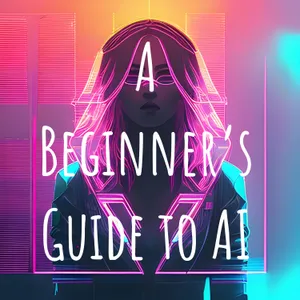Podcast Summary
From simple patterns to photo-realistic AI-generated imagery: The evolution of AI-generated imagery saw a progression from basic shapes to photo-realistic art, fueled by advancements in neural networks and GPU processing power, and democratized by startups and open-source tools.
We've witnessed a remarkable evolution in AI-generated imagery, with recent advancements leading to AI systems capable of creating stunning visuals from text descriptions. This journey began in the 1960s when scientists first explored the potential of computers to generate new content. Early experiments resulted in simple patterns and shapes. However, the introduction of neural networks in the 1990s and 2000s led to more complex paintings. The 2010s saw significant improvements in neural nets and GPU processing power, enabling AI to generate photo-realistic faces and scenes. However, these systems required vast datasets to learn from. Creative coding startups like Runway ML and open-source machine learning frameworks like PyTorch and TensorFlow democratized access to advanced image generation capabilities. The release of DALL-E by OpenAI in 2021 showcased the power of these tools, allowing users to turn bizarre prompts into fantastical artworks. This wave of AI art tools, including Stable Diffusion, Midjourney, and Imogen, continues to democratize AI digital artistry. At the heart of these tools lies generative adversarial networks (GANs), which empower them to create new, original content.
Revolutionizing Creative Industry with AI-generated Imagery using GANs: GANs, a technique using two neural networks, create increasingly realistic images based on text prompts, revolutionizing the creative industry.
AI-generated imagery, specifically through the use of generative adversarial networks (GANs), is revolutionizing the creative industry. GANs, introduced in 2014, are a technique that uses two neural networks - a generator and a discriminator - to create increasingly realistic images based on text prompts. The generator takes the text, converts it into numeric vectors, and passes it through a series of neural network layers to create pixel values for the image. The discriminator classifies the image as real or fake and sends feedback to the generator, which adjusts its parameters to fool the discriminator. This back-and-forth process continues during training, with the generator producing more and more realistic images. This technology is still in its infancy, but it's already being used in creative ways by artists to expand their workflows. The world of AI-generated imagery is rapidly evolving, and it's an exciting time to explore its potential. Stay tuned for more insights into this fascinating topic.
Competing AIs create stunningly detailed images: GANs use adversarial competition to generate detailed images, revolutionizing art and business use cases like DALL E, which creates tailored, on-brand images from quality datasets and refined prompts.
Generative Adversarial Networks (GANs) enable AI image generation by pitting a creative AI against a critical AI in an adversarial competition. This process leads to stunningly detailed images that can barely be distinguished from real photos, even with tiny details like hair follicles, reflections, and textures. The training process involves the generator learning the essence of visual reality from large image datasets, which provide an initial understanding of the visual world. The more diverse data the network sees, the more visual concepts it can learn to apply in novel ways. GANs have the potential to revolutionize the art world and practical business use cases alike, such as DALL E, a commercial platform for creating promotional images with AI. DALL E generates fresh, on-brand images tailored to any concept or need, making it a cost-effective solution for ongoing marketing campaigns. The possibilities are endless, but key principles include using quality datasets and iteratively refining prompts. Stay tuned as we continue exploring the fascinating frontier of AI image generation.
Revolutionizing Visual Content Creation with AI Art Platforms: AI art platforms like DALL-E turn textual descriptions into realistic images, offering incredible potential for individuals and companies to produce high-quality visual content at an affordable price. Use clear descriptions and iterative refinement for best results, and remember ethical considerations.
AI art platforms like DALL-E are revolutionizing visual content creation by turning textual descriptions into realistic images in seconds. These platforms can generate various types of images, from app interfaces to lifestyle shots and mascots, making it easier and more affordable for individuals and companies to produce high-quality visual content. The key to getting the best results is through iterative refinement, starting with clear and detailed descriptions and adding modifiers to hone the message. While these platforms offer incredible potential, it's important to remember ethical considerations and thoughtfully guide the process for optimal results. The possibilities for marketing and other innovative use cases are vast, but always use them responsibly. DALL-E and similar platforms are transforming the way we create visual content and opening up new levels of creativity. If you're interested in learning more about how to use AI art platforms effectively, check out my popular new course, "The Essential Guide to Claude 2," available now on Udemy. As one student put it, "I appreciated the teaching style. It felt like a casual conversation that kept me engaged, and I enjoyed his subtle sense of humor." So go ahead and explore the world of AI art platforms, but do so wisely and creatively.
AI as a tool for human creativity: AI amplifies human creativity by generating visually stunning images based on detailed descriptions, encouraging better questions and pushing boundaries
AI image generation tools serve as a powerful amplifier for human creativity and imagination, not a replacement. By providing detailed descriptions of fictional products, companies, or concepts, listeners can collaborate with AI to generate visually stunning representations. This not only showcases the capabilities of these systems but also encourages us to ask better questions and push the boundaries of what's possible. However, it's essential to remember that the purpose and meaning behind these creations are ultimately determined by the stories we tell and the ideas we convey. Creativity remains a uniquely human trait, and AI is a tool that can help us explore new frontiers and bring our wildest visions to life. As we continue to engage thoughtfully with these technologies, we'll unlock endless opportunities for artistic expression and innovation.





